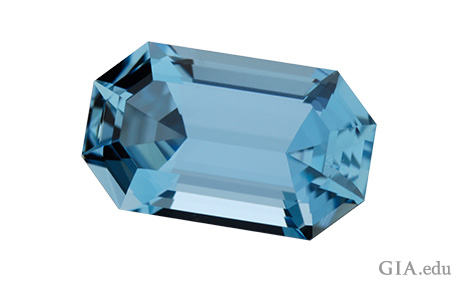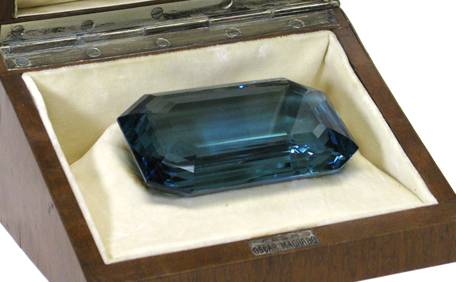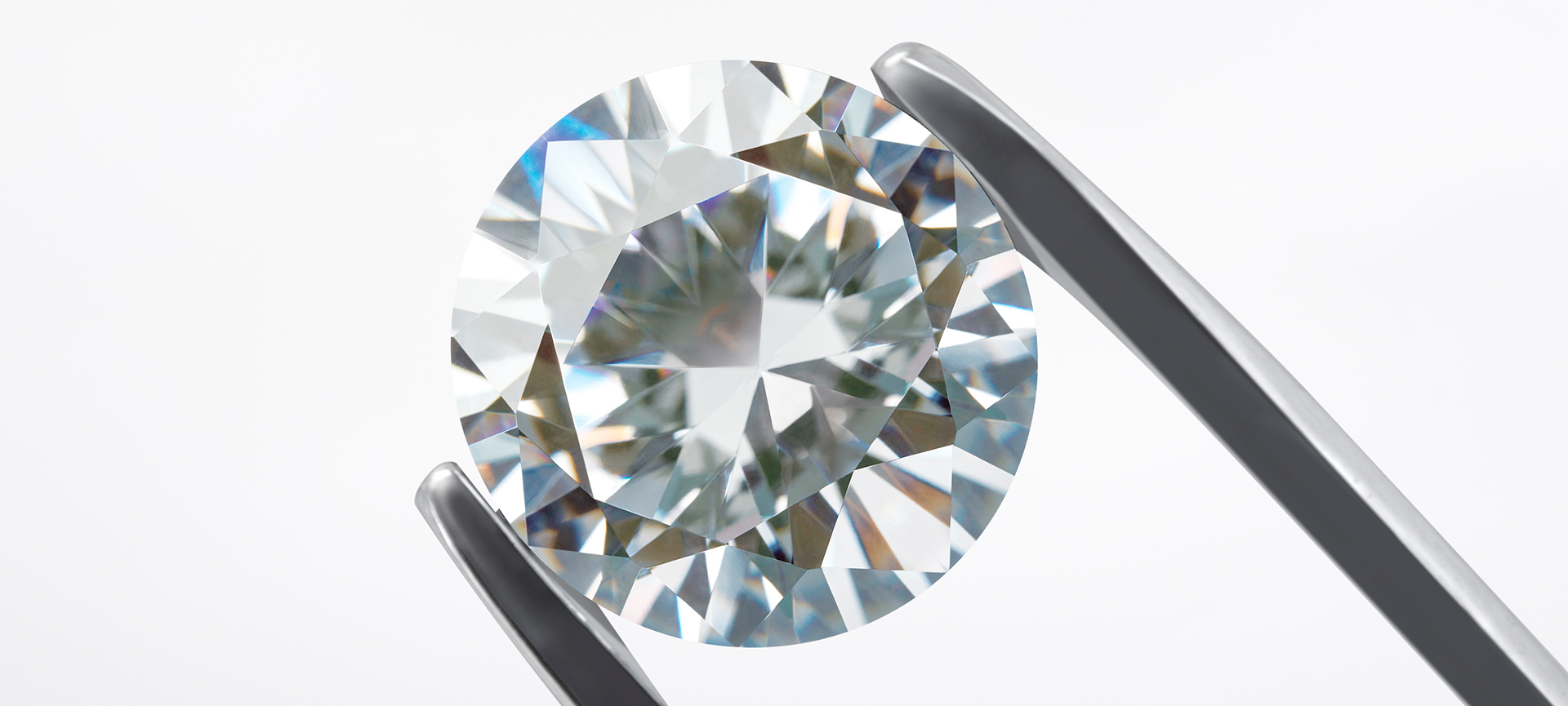Winter is on the way out; aquamarine is on the way in. The placid hues of the March birthstone are a tranquil antidote to the season’s bluster. Read on to learn more about this gorgeous gem and how to pick a beautiful one.
In this post, we’ll cover:
Gemological Information on Aquamarine
Aquamarine History & Lore
Where Aquamarine Comes From
Qualities to Look for in an Aquamarine
Aquamarine Care & Cleaning
March Birthstone: Gemological Information on Aquamarine
Aquamarine is the green-blue to blue variety of the mineral beryl. (Emerald is the green to bluish green variety of the same mineral.) Most of the aquamarine in the marketplace is a light pastel slightly greenish blue. Traces of iron in beryl’s crystal structure cause aquamarine’s color. Like many beryls, aquamarine may form as large crystals suitable for exceptionally large fashioned gems and carvings.
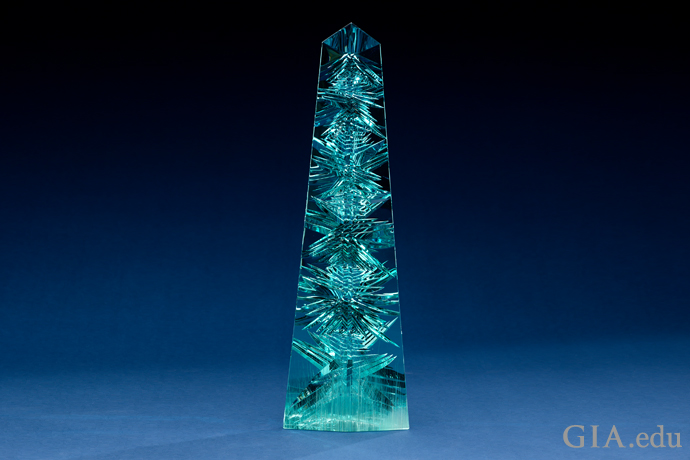
A celebrated attraction at the Smithsonian Institution, the 10,000+ carat Dom Pedro Aquamarine has been described as “the one gem that can rival the Hope Diamond.” Courtesy: Donald E. Hurlbert, Smithsonian Institution
March Birthstone: Aquamarine History & Lore
Aquamarine’s name comes from the Latin for seawater, and ancient mariners claimed the gem would calm waves and keep sailors safe at sea. March’s birthstone was also thought to bring happiness to marriages. Beryl was believed to give the wearer protection against foes in battle and litigation. It was also thought to make the wearer unconquerable and amiable, and to quicken the intellect.
Aquamarine is not only the birthstone for March, the gem is also given as a present on the 19th wedding anniversary. As for famous ones, in 1936 the government of Brazil gave First Lady Eleanor Roosevelt a dark blue rectangular step cut aquamarine that weighed 1,298 carats (ct). It was the larger of two stones faceted from a piece of aquamarine rough that itself weighed an impressive 2.9 pounds (1.3 kilograms). It is now housed at the Franklin D. Roosevelt Presidential Library and Museum in Hyde Park, New York. A celebrated attraction at the Smithsonian Institution is the 10,363 ct Dom Pedro Aquamarine – believed to be the largest faceted aquamarine in the world. The 14 inch (36 centimeter) high obelisk was fashioned by acclaimed German lapidary Berndt Munsteiner using the fantasy cut technique.

The government of Brazil gave this 1,298 ct rectangular step cut aquamarine to Eleanor Roosevelt when she and President Roosevelt visited Rio de Janeiro in 1936. Courtesy: The Franklin D. Roosevelt Presidential Library and Museum, Hyde Park, New York.
March Birthstone: Where Aquamarine Comes From
The Brazilian state of Minas Gerais has been an important source of aquamarine for the past two centuries. Travel there and you’ll find a changing panorama of landscapes: rocky hills, rivers and scrub brush dominate the central and eastern regions; savannahs, forests and streams checker the west; and lush green hills roll southward. Aquamarines are found in primary (hard rock) and secondary (weathered) pegmatite deposits in the eastern portion of the state, near the gem center of Teófilo Otoni.

Disguised as “love doves,” 14K white gold prongs hold a 32 ct cushion cut aquamarine from Brazil. Courtesy: Loretta Castoro Signature Collection
Aquamarine is also found high in the Karakorum foothills of Pakistan. To reach the deposits, miners must climb steep paths to elevations of 9,800 to 13,000+ feet (3,000 to more than 4,000 meters) and work the sides of forbidding cliffs. Below this inhospitable rocky world lie fertile valleys, rushing rivers and small towns. Aquamarine from this area has been described as “water clear.”
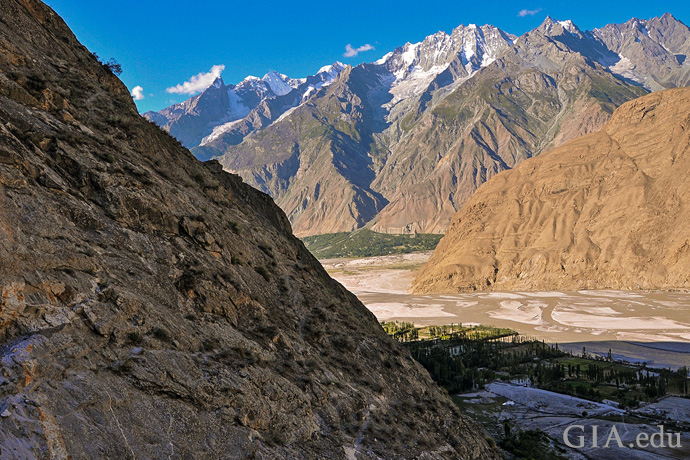
A sliver of an opening (on the far left) is the entrance to an aquamarine mine. Pakistan’s gem-rich Shigar Valley lies between foothills of the majestic Karakoram range. Photo: Vincent Pardieu/GIA
Aquamarine is also mined in Kenya, Madagascar, Nigeria, Zambia and Mozambique, as well as elsewhere in Africa. U.S. sources include the Mount Antero area of Colorado (it’s the state gem) and California’s Riverside and San Bernardino counties. In addition, aquamarine has been found in China, Myanmar, Russia and Ukraine, among other countries.
March Birthstone: Qualities to Look for in an Aquamarine
Aquamarine is pastel blue, greenish blue or green-blue. The preferred color is a moderate slightly greenish blue to dark blue. Fine stones are an even blue with no bands of color (called “zoning”). Most faceted aquamarines are free of eye-visible inclusions. Aquamarine is readily available in large sizes – with many fine gems 25 ct or greater. Aquamarine can be cut into almost any shape, and is often fashioned as emerald cuts, pear shapes, or round or oval brilliants. It also lends itself well to fantasy cuts.

A delightfully icy look: a 10.06 ct pear shaped aquamarine is surrounded by 72 round diamonds (0.35 carats) that are set in platinum. Courtesy: Omi Privé
March Birthstone: Aquamarine Care & Cleaning
With a hardness of 7.5 on the Mohs scale, aquamarine is durable enough for everyday wear. Caring for the gem is easy. Use warm water, mild dish soap and a toothbrush to scrub behind the stone where dirt can collect. Ultrasonic cleaners and steam cleaning are usually safe options as long as there are no feathers or liquid inclusions in the gem.
Nearly all the blue aquamarine in jewelry is produced by heat treatment of bluish green, green, greenish yellow and even brownish yellow beryl. The process removes the yellow color component and leaves a purer blue hue. The treatment is undetectable and appears to be permanent.
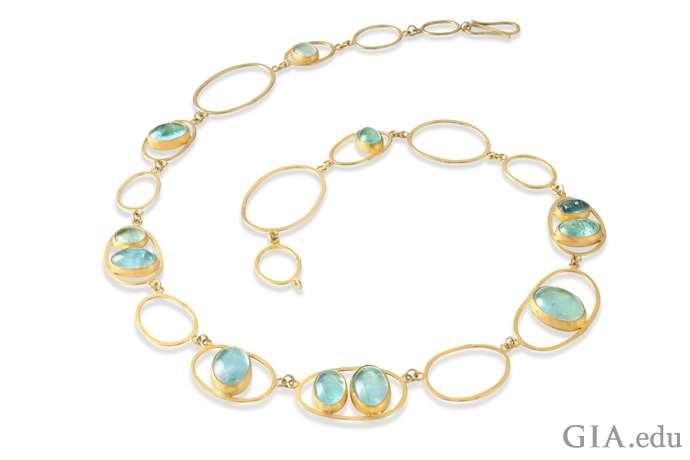
The aquamarine cabochons in this necklace look like drops of water from the Caribbean. Courtesy: Petra Class
The March birthstone aquamarine has it all: It’s beautiful, eye clean, rich in lore and exceptionably wearable. Now you know how to pick one that will become a cherished addition to your jewelry wardrobe.
Born in March? Pisces and Aries are your zodiac signs. Jewelry designers have fashioned some creative pieces, and we’ve found ones for you to enjoy.

